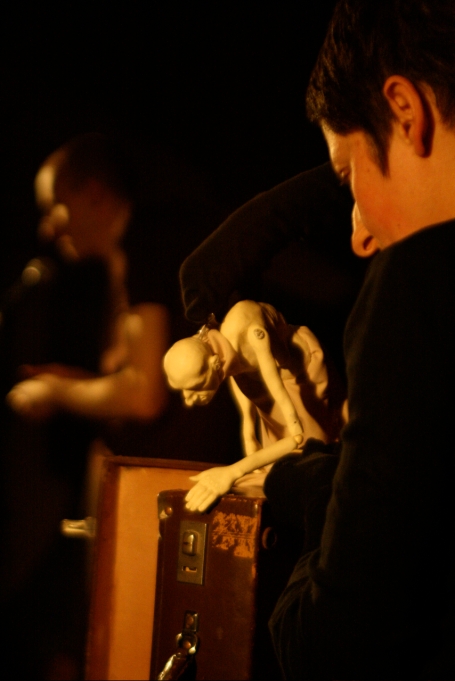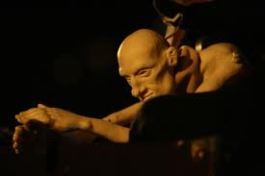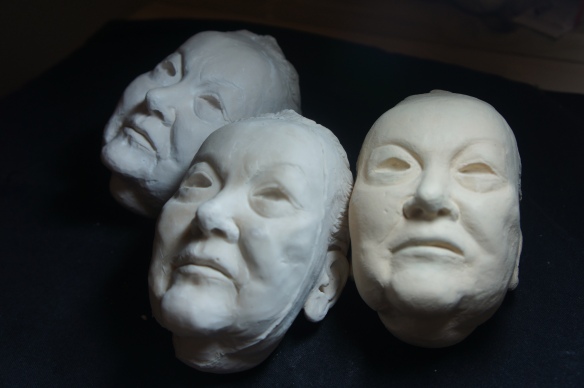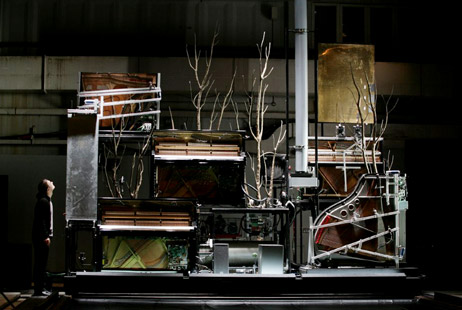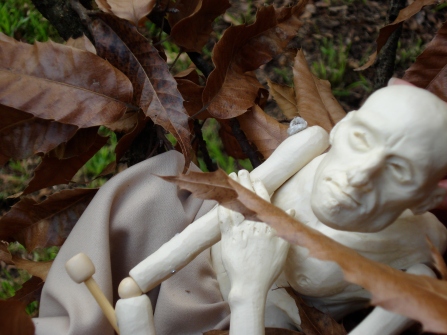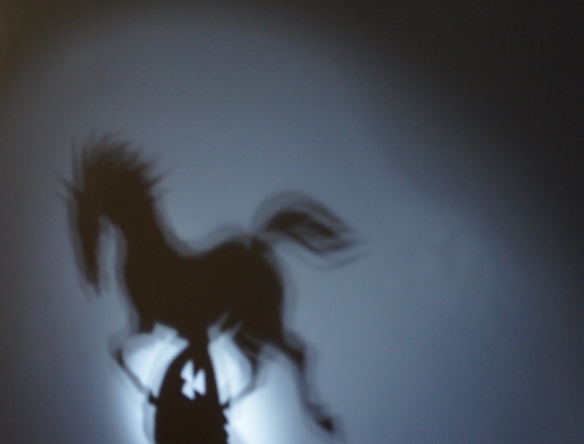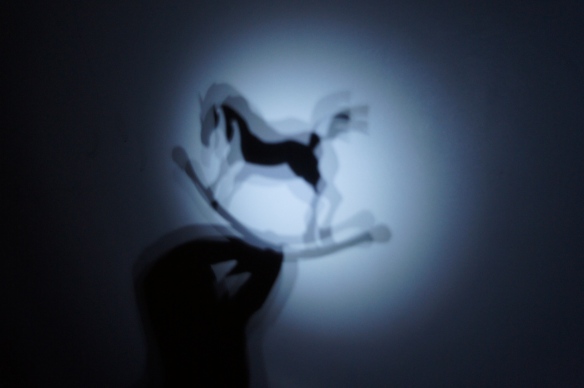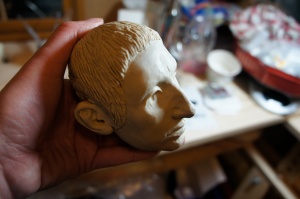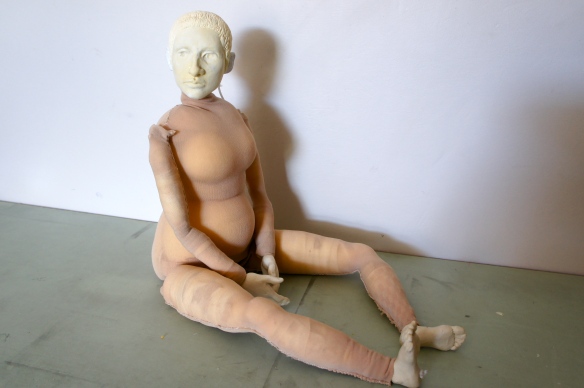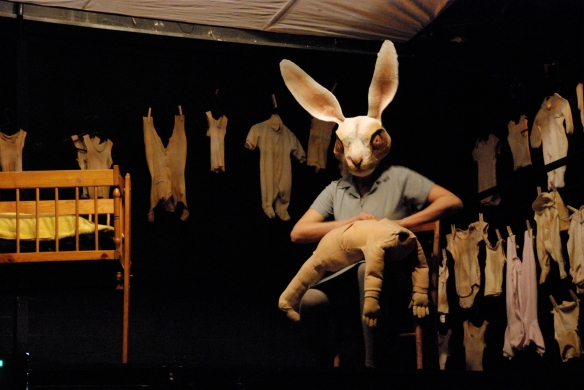Ambiguous Mirrors is the first collaboration between myself and my partner Andy Jackson. The work, a puppetry/poetry collaboration is a response to Andy’s poem ‘9/10/1973 M3’ which explores the emotional and physical legacy of the poet’s deceased father. Andy shares the rare genetic condition ‘Marfans syndrome’ with the father who he never came to know. For Andy the condition has meant living with an unusual physical embodiment – a theme that he evokes and examines in his poetry. In his own words:
The body I inhabit, or perhaps I should say, the body that I am, is visually extraordinary, due to a condition known as Marfan Syndrome. I am six foot three, and weigh around sixty-five kilograms; I am slender, with long limbs. My spine curves dramatically from side-to-side and front-to-back; I would be perhaps six foot six if my spine were straight. In a way, my body has easily adjusted to this shape. But in another way, this is the shape of my body, and it is normal. I do not experience pain or physical difficulty, as some people have assumed. My body experiences its shape in much the same way as any body experiences its shape.
Andy’s incredible poem ‘9/10/1973 M3’, is a meditation on loss, familial similarity and emotional absence. Reading like a poignant conversation with his unknown parent the poem begins:
Knowing only your earth-gripped body can accept this
wreath of questions, I call the Cemetery Trust.
I clutch, for the first time, the date you died, a grid position.
The gates are held open by sleepless weeds,
their shadows unseen, locked inside by the sun.
It’s hot. Removing another layer, I sift the crunch
of dry earth for sympathy in the sound, for some hint
at how I’ll feel when finally face-to-stone,
though I know every echo is open to interpretation.
When I reach your section, I find
it barren, abandoned by flowers and rain.
So many unmarked plots in this desert, no oasis.
The gardeners drive past, trailing boredom and dust.
I walk the aisles until I become just one
more sigh in a crowd of upper-case names.
Grief is not a hand but an absence –
it flies in the breeze echoing in the curves of my ears
and reveals as much of what the grave knows
as the magpie eyeing me from a mute monument.
The portrait puppet I created for this work is a response to both the poem and to Andy’s striking physical presence. Like poetry, puppetry is a rich forum for exploring issues of embodiment and identity – curious about the potential ‘conversation’ between our art forms we collaborated, uncovering connections between object, word, physicality and memory. At times this was a disconcerting process for both of us. For me I was aware that I was dealing with an incredibly sensitive area of Andy’s life and also working directly with his likeness (a process which is never easy , but is particularly heightened for Andy who lives with a visibility that few of us have experienced). For Andy, he expressed the anxiety of opening such a personal poem to the act of collaboration – and also to be faced with a tiny emergent ‘Doppleganger’ in clay was at times harrowing and highly emotional.
Like a hall of mirrors this project began to unfold – the puppet coming to represent both Andy (child and adult), his deceased father (with whom he shared an uncanny likeness) and an entity in it’s own right.
In the shadow of the Ring Road overpass,
I wait at the bank of the creek for your image
to appear, your arms to reach out and around me.
Apart from death, movement is the only constant.
Ducks glide past rubbish – this is the consolation.
You don’t keep the appointments I make, you slip in
through fissures between thoughts that collapse
as I catch myself in shop windows and see
your nose, your hairline, your spine…
My dead father, the roaring trucks overhead
couldn’t care less, and the neck of the youngest
swan is strong enough to break a human arm
or heart. I want the texture of feathers to speak
to this skin, to smother my fear I will never be held.
The result has been a simple, but emotionally charged and visually arresting work which has captured audiences at various literary festivals across Australia. Now we have been invited to share this work with audiences in Cork, Galway and Clifden. We are incredibly honoured to have been invited and are intensely curious to experience audience feedback in another country. Andy and I are currently planning to work up triptych of poems into another visual theatre collaboration – this process has been deeply rewarding and held rich revelations along the way.
As you know we are currently raising funds towards our tour – please consider pledging to this project. There are rewards associated with your pledges – yes, we will gift you with poetry and your own cast of the puppets hands or head depending on your donation.
To donate click on this link, any contribution will be deeply appreciated:
http://www.pozible.com/project/27597/
I will finish this post with Andy’s beautiful words – on seeing a photo his late father -the poem concludes:
She hands me a photo.
Sense-memories I’ve wanted so much erupt in my skull.
In a cigarette-scented black suit and tie, salesman-like,
you sit solid on the porch. I rest on your lap, gazing away,
my child-face vague and adrift as if already swimming
the channels within. Are you in here? Your big hands
and slim fingers close around us like unsaid things.
You are looking into the camera, into her I guess.
In this shot, I can’t see the unnerving curve
of your back, but I know. You didn’t talk about it,
your body a vault that ran out of air. Later,
different times brushing against each other,
a thunder in my head, I trace the lake slowly,
my bones resounding. Your mother was born
in the century before last. You just got on with it.
Why can’t I? A moorhen senses my feet
crush the grass, signs himself against the sky,
trailing the long red legs he inherited.
To read more about Andy and his poetry go to: amongtheregulars.wordpress.com


